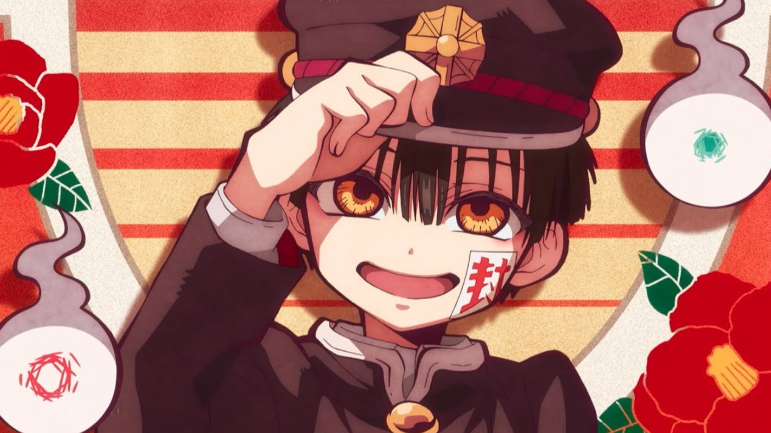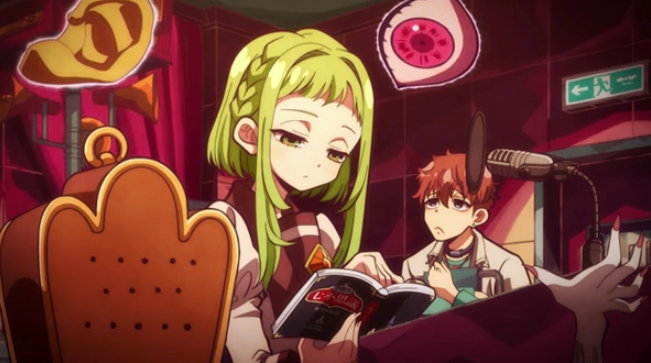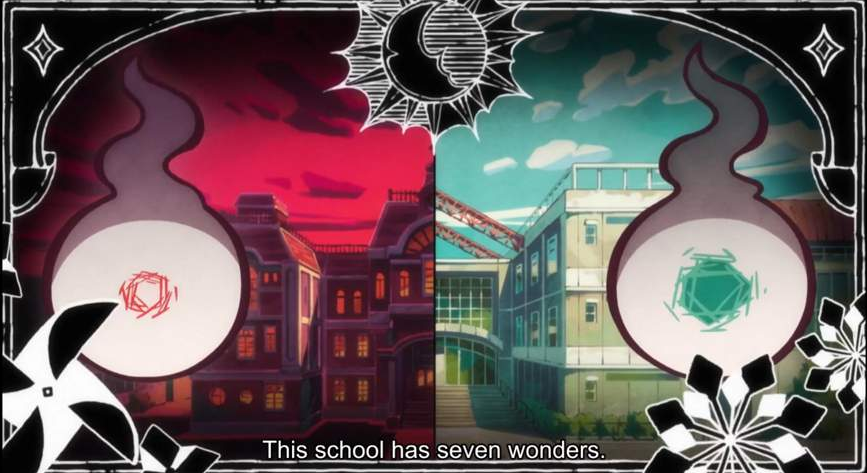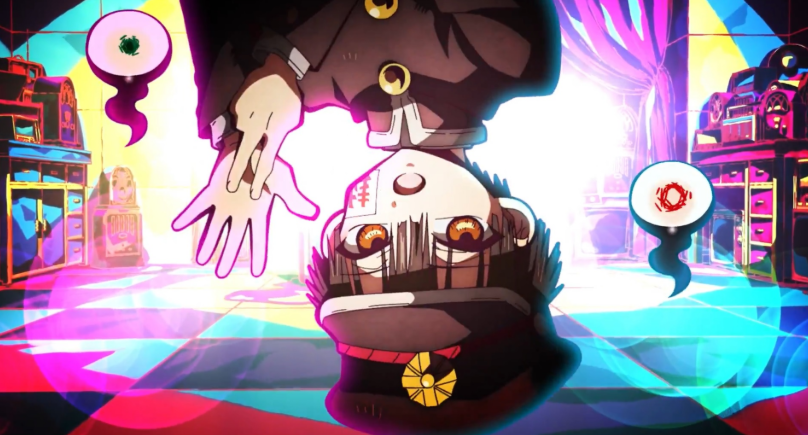Thoughts on ... Toilet-bound Hanako-kun, Season One (Anime Review, no spoilers)
Hanako-kun is like that annoying nephew that you can’t help but SQUEE internally whenever you see him
The best part about quarantine is the endless free hours to do productive things, like reading, writing, and watching anime. Because I love to read, I’ve always leaned towards manga, but towards the end of 2019 and now during the tumultuous beginnings of this year, I committed to watching more anime, particularly the seasonal shorts. So far I haven’t been disappointed by anything I’ve watched, and I now have a growing list of personal favourites. After asking around on twitter for recommendations, Toilet-bound Hanako-kun crested my horizon, and I am now a changed woman.
So, first of all, the title is weird, and it’s the only explanation I can conceive of as to why this series is not as popular as it should be. With twelve episodes, it’s easy to get into, and the arcs covered are action packed, intricate, and unique. Hanako-kun is a perfect showcase of its medium, from the visual gags and the regular use of diverse animation styles, to the unique character designs, the OST, and the absolutely perfect voice cast. As soon as I started the first episode, I was reminded of the stylishly unique animation of Demon Slayer, and was a little sad that the same buzz and excitement of that series had not trickled down onto Hanako-kun. I assume that most people saw the title and disregarded the anime as something lewd and questionable, but the title is just one of the ways in which the series combines frivolous and peculiar comedy with eerie, emotional storytelling. It is so much more than stylish visuals.
This is no doubt the prettiest school toilet I have EVER seen. What exactly is she cleaning? It’s already spotless.
Premise
The series is set in the bizarre Kamome Academy, a school plagued by the Seven Wonders: seven supernatural apparitions that disrupt the every day lives of the students. Knowledge of the Seven Wonders is shared amongst the school populace as rumours. The leader of the Seven Wonders is Hanako-san of the girl’s bathroom: the ghost of a girl who lives in the third cubicle, and who will grant wishes if summoned—but at a price. Nene is a hapless romantic with insecurities about her doughy legs. She summons Hanako to help her win the heart of the most recent object of her affection, and discovers that the ghostly girl is actually a childish and troublesome boy. Hanako-kun vows to assist in her love quest, using numerous hopeless methods, and in exchange, Nene has to be his assistant, cleaning the bathroom and running errands. Over time, they develop a more intimate and complicated friendship, and Nene has to contend with the various apparitions of the school.
The concept of a haunted school isn’t unique. I think the reason why the haunted school is such a common trope is due to its relatability: for many people, school is and/or was, a place of horror. It was the building they dreaded, forced to attend against their will, studying subjects they did not like. School is where people develop their most deeply-grained insecurities, contend with unlikeable teachers and bullies, fall in love and get dumped, lose friends and gain enemies. I think for a lot of writers, haunted schools open a world of opportunities; they explain why the school experience is so horrible for so many young people. Where Hanako-kun flourishes is the use of the age-old school rumour mill to fuel the potency of the apparitions.
At the beginning or the end of every episode, a student starts off with “have you heard?” and proceeds to tell the legend of a member of the Seven Wonders. The student in question is initially anonymous, seemingly spreading the rumour via a telecommunications station in an unidentified part of the school. Once the rumour has been heard, the rest of the school quickly disseminates the information, as expected of school children. Unbeknownst to them, however, is that the Seven Wonders are all but contracted to enact the details of the rumours, otherwise they will lose their powers and cease to exist. There’s an interesting lesson here about the power of words, and how just a silly rumour can actually be the breaking point for its subject. The motive of the rumour-maker is further explored in subsequent episodes, a storyline that incorporates Hanako-kun’s past and possible future as the Seventh Wonder—and apparition leader—of the school.
Also notable is how the Wonders all possess their own worlds, called Boundaries, which are spaces between the world of the living and the dead. If students unwittingly enter a Boundary, they are at the mercy of the Wonder. Nene’s friendship with Hanako-kun puts her in the firing line for their supernatural schemes, and she often finds herself trapped in a Boundary, forced to undertake all manner of tasks to survive and escape. To weaken the Boundary, she has to break the Wonder’s most treasured possession, called a Yorishiro, which then becomes a clever device to learn more about the Wonder’s life as a human.
Sometimes, this history produces painful results, and the guilt and burdens of the apparitions are revealed to Nene and her de-facto sidekick, Kou Minamoto, an heir of the famous Minamoto Family of exorcists, who decides to delay exorcising Hanako and the Wonders once he realises that not all apparitions are evil. Kou’s friendship with one particular apparition who is put through so much hardship in the afterlife is heartbreaking to watch. Oftentimes, Nene and Kou are reminded by Hanako that the living cannot do anything for the dead. It serves as a poignant lesson in appreciating the people in our lives when they are still with us, instead of burdening their graves with pretty flowers once they’re gone. Kou learns this lesson tenfold, and Nene’s deepening friendship with Hanako leads her to try and resolve his past, even though she knows this cannot be changed. Their relationship makes the viewer feel so wistful for a pairing that works so well, but can only ever go so far.
A lot of the comments beneath the individual episodes were from manga readers who warned that things get “very, very dark”. Now as someone who reads Berserk and whose favourite manga includes Goodnight PunPun and Assassination Classroom, I have particular expectations of what “dark” is. If you’re expecting graphic violence, deep-seated heartbreak, long explorations into depression, suicide and death, then I wouldn’t say that Hanako-kun matches those things, however, the darker nature of the anime stems from the stifling nature of the school, the troubled past of Hanako, the tragic pasts of the Wonders, the cruel experiences that some characters have to endure, and the overall theme of death that permeates the narrative. Some sequences are genuinely chilling and tense, and when a particular apparition is introduced to the story, the tonal shift changes quite drastically, and you are left anticipating when this apparition will return to cause more harm to Hanako and his new human friends. So I would say the series is more eerie than dark.
In a way, they’re all hopeless
characters
Kamome Academy is filled with eccentrics. Nene is a wild dreamer with a weakness for princely boys. She gets ensnared in many a supernatural trap because of a pretty face, or a shallow compliment about her looks, or conversely, if a disparaging comment is made about her “daikon” legs. She becomes inextricably linked with Hanako after her wish for love goes wrong, and in her anger, she swallows what she believes to be a special love talisman that Hanako was hiding from her, and instead is inflicted with a mermaid’s curse, totally dependent on Hanako for help. The curse is just one of the many problems Nene brings upon herself, but her hapless romantic character is charming and provides moments of much needed brevity. In contrast, the serious Kou, burdened with the responsibilities of his clan, and struggling with living in the shadow of his more accomplished and popular older brother, regularly tries to refocus both Nene and Hanako, who are prone to silly distractions.
The careless leader.
The cherry on the cake is Hanako, voiced by the fabulous Megumi Ogata. Childish, troublesome, formidable and mysterious, the Seventh Wonder uses his genuinely aloof nature as a coping mechanism and a shield to hide what is clearly a distressing childhood past. The nature of his death is not yet known by the end of this season, but he makes a promise to explain everything to Nene at the right time. As alluded to during the opening credit sequence (accompanied by a fantastic theme song from Chibaku Shonen Band) Hanako suffered as a child, and once his past comes to the forefront of the narrative, it is clear he still suffers from the painful memories of that time. The switch from careless, amiable Hanako to the very frightened, wide-eyed child is startling, providing enough clues to anticipate a devastating reveal in the recently confirmed Season Two.
There is a wider cast of school characters who may not take centre stage, but are fleshed out enough that their individual personalities are distinct and familiar. Aoi, Nene’s popular best friend, loves a good gossip, as shown by her eagerness to report the latest supernatural rumour to Nene. The Wonders revealed so far in Season One have fantastic designs and abilities. They all nurse their own personal tragedies, and have varying relationships with Hanako. Of particular note is the witty and sarcastic 4 o’clock Bookcase, the Fifth Wonder of the school library. He plays a somewhat fatherly figure to the main trio, and provides a calming presence to every scene he features in.
Confusion: one of Nene’s most common expressions
animation
The animation is one of the series strengths. Everything is exceptionally colourful, and the character designs are unique. Considering these are all high school students, they all possess a chibi-like, rounded quality, which contrasts the chilling tone of the story itself. There are some visually stunning still frames that are used to introduce location switches or to denote the passing of time. Conversations between characters are then punctuated with manga-style panels, displaying a character’s comedic reaction, moments of thought, flashes of anger, or internal monologues. Other animation styles are incorporated, with some watercolour moments during quiet transitions, and then glaring pop art and subtle CGI during conflicts. My husband is an occasional anime watcher, and he saw a few minutes of Hanako-kun and said “yeah there’s too much going on”. It can take a while to get used to it if you’re unaccustomed to the media as a whole, but for most anime watchers I think it will be a much more refreshing experience.
It’s all so beautiful.
conclusion
If I was to say anything negative about the series, it would be the lack of conclusion to Hanako’s story. It is hinted at the halfway point that there is more to this apparition than meets the eye, and we are teased regularly with clues about his past, but it isn’t fully resolved. I wouldn’t say this is a bad thing, because it obviously increases the suspense and mystery, and I think ending the subject with the promise to one day reveal everything to Nene is a fair temporary conclusion to something that will undoubtedly reemerge in a later season.
I really hope more people get into this. Don’t let the title fool you! It’s a fun, unique series with a lot of heart.
9/10







